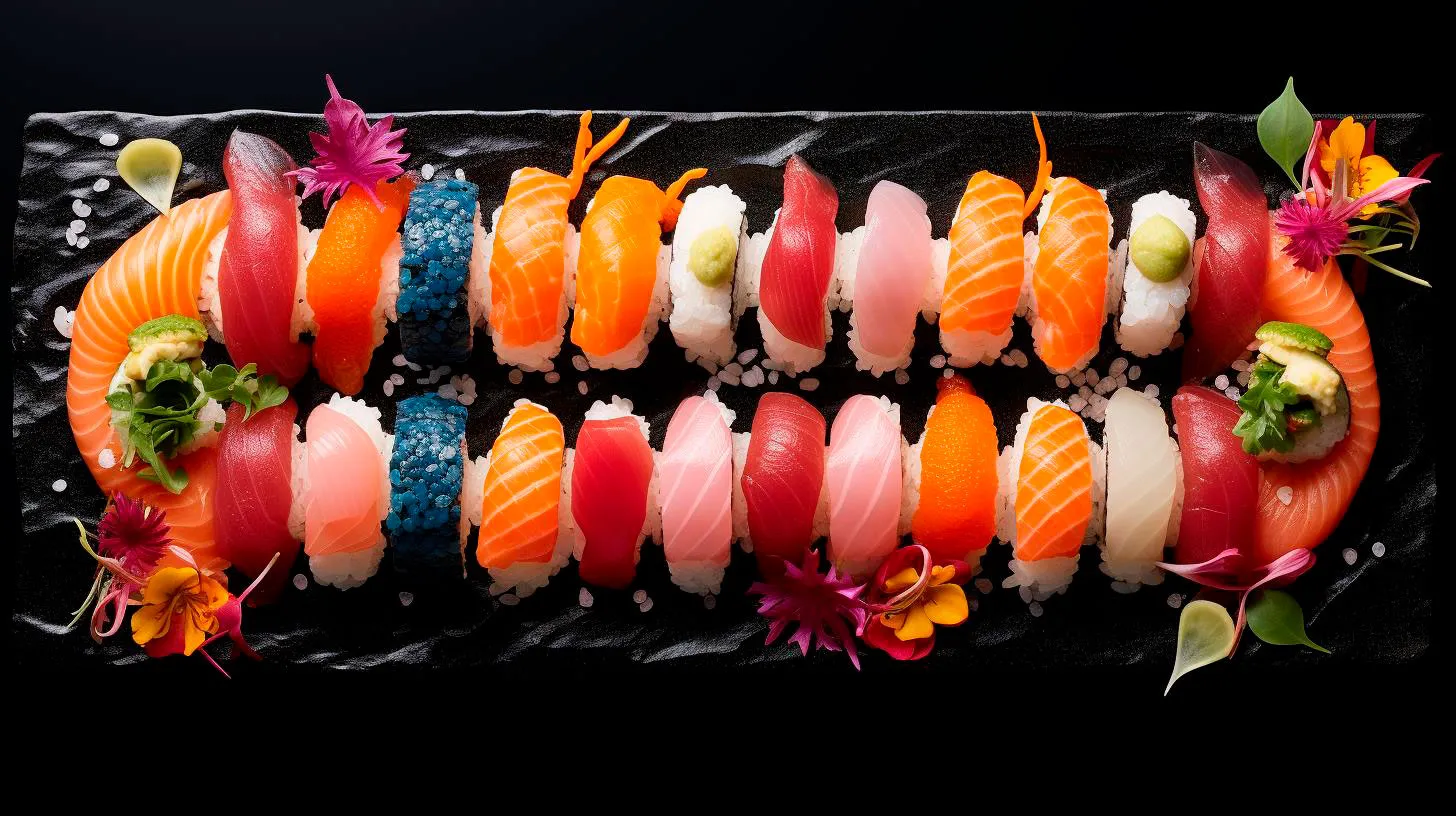Sushi for Beginners: A Step-by-Step Guide to Trying this Japanese Delicacy
If you have always been curious about trying sushi but are unsure where to start, fear not! This guide will provide you with a step-by-step journey into the world of sushi, from understanding the basics to enjoying your first plate.
Understanding Sushi
Before diving into the details, let’s understand what sushi really is. Sushi is a Japanese dish made primarily with vinegared rice combined with various ingredients such as raw or cooked seafood, vegetables, and sometimes even tropical fruits. The combination of flavors and artistic presentation make sushi a unique and unforgettable dining experience.
Let’s explore the key components of sushi:
- Sushi Rice: The foundation of any sushi roll is the specially prepared sushi rice. It is short-grained rice seasoned with vinegar, salt, and sugar, giving it a tangy yet mildly sweet flavor.
- Nori: Nori is a type of edible seaweed that wraps around the sushi rice and holds the ingredients together. It adds a contrast of texture and a subtle umami taste.
- Sashimi: Sashimi refers to thin slices of raw fish or seafood. It is often served alongside or on top of sushi rice and is a highlight for many sushi lovers.
- Fillings: Sushi can be filled with a variety of ingredients, such as fish, shellfish, vegetables, pickled radish, avocado, or even tropical fruits like mango. The possibilities are endless!
- Sauces and Condiments: Soy sauce, wasabi, and pickled ginger are common accompaniments to sushi. These condiments enhance the flavors and provide a well-rounded taste experience.
Now that we have covered the basics, let’s move on to the step-by-step process of enjoying sushi.
Step 1: Choosing a Sushi Restaurant
Begin your sushi journey by selecting a reputable sushi restaurant known for its quality and freshness. Look for positive online reviews, recommendations from friends, or seek guidance from local food enthusiasts. Opting for an authentic Japanese restaurant is highly recommended to ensure an immersive experience.
Key Takeaways:
- Choose a sushi restaurant known for its quality and freshness.
- Opt for an authentic Japanese restaurant for an immersive experience.
Step 2: Menu Exploration
Once you have chosen a restaurant, it’s time to explore their menu. Sushi menus can be extensive, featuring a wide array of options to cater to different preferences. If you are a beginner, it’s best to start with basic rolls or nigiri sushi, which usually consist of a single slice of fish on top of a small mound of rice. This allows you to savor the flavors without overwhelming your taste buds.
Key Takeaways:
- Start with basic rolls or nigiri sushi as a beginner.
- Explore the menu to understand the different options available.
Step 3: Ordering and Dining Etiquette
When you are ready to order, don’t hesitate to seek assistance from the sushi chef or the staff. They can guide you through the menu, recommend popular choices, and address any dietary concerns. Japanese dining etiquette is important, so remember to be respectful and mindful of the cultural norms.
Key Takeaways:
- Consult the sushi chef or staff for guidance and recommendations.
- Follow appropriate Japanese dining etiquette and manners.
Step 4: Dive In!
Once your sushi arrives, it’s time to dive in and enjoy your culinary adventure! Take small bites, allowing the flavors to unfold in your mouth. Experiment with different combinations of condiments, like dipping a piece of sushi lightly in soy sauce or adding a touch of wasabi for a spicy kick. Don’t be afraid to try new flavors, textures, and ingredients.
Key Takeaways:
- Take small bites to savor the flavors.
- Experiment with condiments to enhance your taste experience.
Step 5: Trying New Varieties
As you become more comfortable with sushi, don’t hesitate to explore different varieties. Sushi is an evolving art form, and there is always something new to discover. Try different rolls, sashimi, or even unique creations offered by the sushi chef. This allows you to broaden your palate and appreciate the diverse world of sushi.
Key Takeaways:
- Explore different varieties of sushi as you become more familiar with it.
- Try unique creations offered by the sushi chef.
In Conclusion
Sushi is not just a meal; it’s an adventure for your taste buds. By following this step-by-step guide, you can embark on a culinary journey and discover the wonders of this Japanese delicacy. Remember to start with the basics, choose a reputable sushi restaurant, and explore different flavors. Whether you become a sushi aficionado or simply enjoy occasional sushi outings, this guide will ensure you have an enjoyable and unforgettable experience.
So, why wait? Take a leap into the world of sushi and let your taste buds dance!
Sushi Fusion: Combining Traditional and International Elements for a Unique Dining Experience
The Rise of Sushi Fusion
Sushi fusion has gained tremendous popularity around the world, thanks to its ability to offer a diverse range of flavors and textures. This culinary trend has successfully merged traditional sushi with elements from other cuisines, creating innovative and exciting dishes that appeal to both sushi aficionados and adventurous foodies.
The fusion of traditional and international elements in sushi provides an opportunity for chefs to experiment and push culinary boundaries. By incorporating global ingredients, flavors, and cooking techniques, sushi fusion restaurants are able to attract a broader customer base and offer unique dining experiences.
Features and Advantages of Sushi Fusion
1. Flavor Exploration: Sushi fusion allows diners to explore a diverse range of flavors that marry traditional Japanese ingredients with international elements. From spicy tuna rolls with a hint of Mexican flavors to sushi burritos inspired by American fast food, sushi fusion offers an exciting culinary adventure.
- Key takeaway: Sushi fusion allows for an extraordinary flavor exploration that caters to diverse palates.
2. Creative Presentation: Sushi fusion restaurants prioritize creativity in their presentation, offering beautifully crafted dishes that are a feast for both the eyes and taste buds. These innovative platings showcase the artistry of the chefs and create an immersive dining experience.
- Key takeaway: Sushi fusion offers not only delicious flavors but also visually appealing presentations that enhance the overall dining experience.
3. Expanded Menu Options: Sushi fusion expands the options available to diners, featuring a wide range of sushi rolls, nigiri, sashimi, and unique creations that incorporate international ingredients. This allows customers to choose from a variety of flavors, ensuring there is something for everyone.
- Key takeaway: Sushi fusion offers an expanded menu that caters to different tastes and preferences.
Statistics on Sushi’s Global Popularity
Sushi’s popularity has skyrocketed globally, and its influence can be seen in various countries around the world:
– The global sushi market is forecasted to reach $22.7 billion by 2027, growing at a CAGR of 6.0%. (Source: Grand View Research)
– The United States is the largest consumer of sushi outside of Japan, with sushi restaurants experiencing a 5.9% annual growth rate. (Source: IBISWorld)
– Sushi consumption in the UK has increased by 38% in the past five years. (Source: Reuters)
The Future of Sushi Fusion
The sushi fusion trend shows no signs of slowing down. As more people seek unique taste experiences and culinary fusion becomes increasingly popular, sushi fusion restaurants are poised to continue evolving and pushing boundaries.
The fusion of traditional and international elements in sushi offers a world of possibilities for both chefs and diners. It allows creative flavors to come together, resulting in a harmonious blend of tradition and innovation that takes sushi to a whole new level.
In Summary
Sushi fusion has revolutionized the way we experience sushi, combining traditional Japanese flavors with international ingredients and cooking techniques. The expanding menu options, creative presentations, and diverse flavor explorations offer a unique and delightful dining experience. As the global popularity of sushi continues to rise, sushi fusion is undoubtedly at the forefront of culinary innovation.
Exploring the World of Sushi: A Gateway to New Flavors
Today, we’ll take you on a journey through the fascinating world of sushi, exploring its origins, types, health benefits, and why it is worth adding to your culinary repertoire.
A Brief History of Sushi
Sushi dates back to 2nd-century China, where it was originally a way of preserving fish in fermented rice. It was during the 8th century that Japanese chefs refined the technique, introducing vinegar to the rice as a natural preservative. This innovation gave rise to the sushi we know and love today. Over time, sushi became popular in Japan, particularly in Edo (now Tokyo), where street-side sushi stalls thrived. With the advent of refrigeration, sushi began to spread globally and underwent further transformations to suit different palates.
The Diversity of Sushi
Sushi is not limited to the traditional Japanese delicacy of raw fish wrapped in rice and seaweed. In fact, it encompasses a wide range of styles, ingredients, and preparations, catering to diverse palates and dietary preferences. Here are a few popular types of sushi you should know about:
- Nigiri: Thin slices of raw or cooked fish placed on bite-sized pillows of rice.
- Sashimi: Fresh, raw seafood served without rice, highlighting the delicate flavors of the fish.
- Maki: Rice and fillings (such as fish, vegetables, or other ingredients) rolled in seaweed sheets and sliced into bite-sized portions.
- Temaki: Hand-rolled cones of seaweed filled with rice, fish, and vegetables, resembling an ice cream cone in shape.
- Uramaki: Inside-out rolls where rice is on the outside, and fillings are wrapped in a layer of seaweed and rice.
The Health Benefits of Sushi
Apart from its delectable taste, sushi offers several health benefits. When made with fresh ingredients, sushi can be a nutritious and low-calorie option. Here are some notable advantages of incorporating sushi into your diet:
- High-Quality Protein: Sushi is packed with lean proteins like fish, which are essential for muscle growth and repair.
- Omega-3 Fatty Acids: Fish like salmon and tuna are rich in omega-3 fatty acids, which promote heart health and have anti-inflammatory properties.
- Antioxidants and Vitamins: Sushi often includes vegetables like avocado, cucumber, and seaweed, which are excellent sources of vitamins, minerals, and antioxidants.
- Low in Saturated Fat: Sushi, especially sashimi, is low in saturated fat, making it a healthier alternative to many other protein-rich dishes.
Key Takeaways
Exploring the world of sushi is not only a culinary adventure but also an opportunity to embrace the diverse flavors it has to offer. Here are the key takeaways to remember:
- Sushi originated in Japan and has a rich history dating back centuries.
- There are various types of sushi, including nigiri, sashimi, maki, temaki, and uramaki.
- Sushi is not only delicious but also provides numerous health benefits, such as high-quality protein, omega-3 fatty acids, and essential vitamins and minerals.
Dive into the world of sushi and unleash your taste buds to new and exciting flavors. Whether you’re a sushi aficionado or a first-time explorer, this culinary journey will undoubtedly leave you craving more. Venture outside your comfort zone and experience the wonders of sushi – a gateway to a world of taste.
Adapting Sushi Making it Suitable for Every Palate
Today, sushi can be enjoyed by everyone, irrespective of their dietary restrictions or preferences. In this article, we explore the various adaptations of sushi that make it suitable for every palate.
1. Vegetarian and Vegan Sushi
For those who prefer to avoid meat or animal products, vegetarian and vegan sushi options are readily available. These alternatives allow individuals to savor the unique flavors and textures of sushi while adhering to their dietary choices. Some popular vegetarian sushi options include:
- Avocado Roll: Fresh avocado slices wrapped in seasoned seaweed and sushi rice.
- Cucumber Roll: Crisp cucumber sticks enveloped in sushi rice and seaweed.
- Asparagus Roll: Grilled asparagus spears enveloped in sushi rice and seaweed.
These vegetarian sushi options showcase a balance of flavors, offering a delightful dining experience for sushi enthusiasts who follow a plant-based diet.
2. Cooked Sushi
While raw fish is synonymous with traditional sushi, cooked sushi varieties have gained significant popularity. Cooked sushi ensures that individuals who are apprehensive about consuming raw fish can still enjoy a delectable and safe sushi experience. Some popular cooked sushi options include:
- Tempura Roll: Crunchy tempura-battered vegetables or shrimp wrapped in sushi rice and seaweed.
- Unagi Roll: Grilled eel glazed with a savory-sweet sauce, rolled with sushi rice and seaweed.
- Teriyaki Chicken Roll: Grilled teriyaki chicken wrapped with a layer of sushi rice and seaweed.
These cooked sushi varieties offer a plethora of flavors, textures, and aromas, providing an excellent alternative for those who prefer their fish cooked or want to try something new.
3. Fruit Sushi
As sushi continues to evolve, fruit sushi has emerged as a delightful fusion of traditional sushi with a refreshing twist. Fruit sushi is not only visually appealing but also a perfect choice for those with a sweet tooth. Examples of popular fruit sushi options include:
- Mango Roll: Sushi rice wrapped with fresh mango slices, drizzled with a tangy sauce.
- Strawberry Roll: Sushi rice wrapped with ripe strawberries, topped with a strawberry puree.
- Kiwi Cucumber Roll: A blend of kiwi slices and cucumber sticks wrapped with sushi rice and seaweed.
Fruit sushi provides a burst of natural sweetness and vibrant colors, making it an ideal choice for a refreshing dessert or a unique party treat.
Key Takeaways
By adapting traditional sushi, innovative variations have been developed to cater to different dietary preferences and to suit everyone’s palate:
- Vegetarian and vegan sushi options feature ingredients like avocado, cucumber, and asparagus.
- Cooked sushi varieties offer alternatives for those who prefer their fish cooked or are averse to raw fish.
- Fruit sushi combines the sweetness of fresh fruits with the artistry of sushi preparation.
With these adaptations, sushi has transformed into a versatile dish that can be enjoyed by individuals with various taste preferences and dietary needs. Next time you crave sushi, be sure to explore these alternatives and experience the enticing world of flavors that sushi has to offer!



